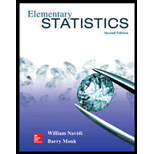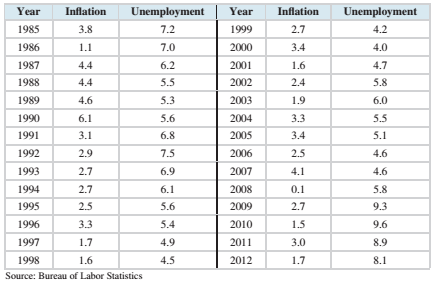
Concept explainers
The following table, Reproduce from chapter introduction. Presents the inflation rate and unemployment rate, both in percent, for the years 1985-2012

We will investigate some methods for predicting unemployment first. We will try to predict the unemployment rate from the inflation rate.
Compute the least-squares line for predicting unemployment from inflation.
To calculate: To compute the least squares regression line for the given data set.
Answer to Problem 2CS
Explanation of Solution
Given information:
The following table presents the inflation rate and unemployment rate, both in percent, for the years 1985-2012.
| Year | Inflation | Unemployment |
| 1985 | 3.8 | 7.2 |
| 1986 | 1.1 | 7.0 |
| 1987 | 4.4 | 6.2 |
| 1988 | 4.4 | 5.5 |
| 1989 | 4.6 | 5.3 |
| 1990 | 6.1 | 5.6 |
| 1991 | 3.1 | 6.8 |
| 1992 | 2.9 | 7.5 |
| 1993 | 2.7 | 6.9 |
| 1994 | 2.7 | 6.1 |
| 1995 | 2.5 | 5.6 |
| 1996 | 3.3 | 5.4 |
| 1997 | 1.7 | 4.9 |
| 1998 | 1.6 | 4.5 |
| 1999 | 2.7 | 4.2 |
| 2000 | 3.4 | 4.0 |
| 2001 | 1.6 | 4.7 |
| 2002 | 2.4 | 5.8 |
| 2003 | 1.9 | 6.0 |
| 2004 | 3.3 | 5.5 |
| 2005 | 3.4 | 5.1 |
| 2006 | 2.5 | 4.6 |
| 2007 | 4.1 | 4.6 |
| 2008 | 0.1 | 5.8 |
| 2009 | 2.7 | 9.3 |
| 2010 | 1.5 | 9.6 |
| 2011 | 3.0 | 8.9 |
| 2012 | 1.7 | 8.1 |
Formula Used:
The equation for least-square regression line:
Where
The correlation coefficient of a data is given by:
Where,
The standard deviations are given by:
The mean of x is given by:
The mean of y is given by:
Calculation:
The mean of x is given by:
The mean of y is given by:
The data can be represented in tabular form as:
| x | y |  |  |  |  |
| 3.8 | 7.2 | 0.97143 | 0.94367 | 1.10357 | 1.21787 |
| 1.1 | 7.0 | -1.72857 | 2.98796 | 0.90357 | 0.81644 |
| 4.4 | 6.2 | 1.57143 | 2.46939 | 0.10357 | 0.01073 |
| 4.4 | 5.5 | 1.57143 | 2.46939 | -0.59643 | 0.35573 |
| 4.6 | 5.3 | 1.77143 | 3.13796 | -0.79643 | 0.63430 |
| 6.1 | 5.6 | 3.27143 | 10.70224 | -0.49643 | 0.24644 |
| 3.1 | 6.8 | 0.27143 | 0.07367 | 0.70357 | 0.49501 |
| 2.9 | 7.5 | 0.07143 | 0.00510 | 1.40357 | 1.97001 |
| 2.7 | 6.9 | -0.12857 | 0.01653 | 0.80357 | 0.64573 |
| 2.7 | 6.1 | -0.12857 | 0.01653 | 0.00357 | 0.00001 |
| 2.5 | 5.6 | -0.32857 | 0.10796 | -0.49643 | 0.24644 |
| 3.3 | 5.4 | 0.47143 | 0.22224 | -0.69643 | 0.48501 |
| 1.7 | 4.9 | -1.12857 | 1.27367 | -1.19643 | 1.43144 |
| 1.6 | 4.5 | -1.22857 | 1.50939 | -1.59643 | 2.54858 |
| 2.7 | 4.2 | -0.12857 | 0.01653 | -1.89643 | 3.59644 |
| 3.4 | 4.0 | 0.57143 | 0.32653 | -2.09643 | 4.39501 |
| 1.6 | 4.7 | -1.22857 | 1.50939 | -1.39643 | 1.95001 |
| 2.4 | 5.8 | -0.42857 | 0.18367 | -0.29643 | 0.08787 |
| 1.9 | 6.0 | -0.92857 | 0.86224 | -0.09643 | 0.00930 |
| 3.3 | 5.5 | 0.47143 | 0.22224 | -0.59643 | 0.35573 |
| 3.4 | 5.1 | 0.57143 | 0.32653 | -0.99643 | 0.99287 |
| 2.5 | 4.6 | -0.32857 | 0.10796 | -1.49643 | 2.23930 |
| 4.1 | 4.6 | 1.27143 | 1.61653 | -1.49643 | 2.23930 |
| 0.1 | 5.8 | -2.72857 | 7.44510 | -0.29643 | 0.08787 |
| 2.7 | 9.3 | -0.12857 | 0.01653 | 3.20357 | 10.26287 |
| 1.5 | 9.6 | -1.32857 | 1.76510 | 3.50357 | 12.27501 |
| 3.0 | 8.9 | 0.17143 | 0.02939 | 2.80357 | 7.86001 |
| 1.7 | 8.1 | -1.12857 | 1.27367 | 2.00357 | 4.01430 |
Hence, the standard deviation is given by:
And,
Consider,
Hence, the table for calculating coefficient of correlation is given by:
| x | y |  |  |  |
| 3.8 | 7.2 | 0.97143 | 1.10357 | 1.07204 |
| 1.1 | 7.0 | -1.72857 | 0.90357 | -1.56189 |
| 4.4 | 6.2 | 1.57143 | 0.10357 | 0.16276 |
| 4.4 | 5.5 | 1.57143 | -0.59643 | -0.93724 |
| 4.6 | 5.3 | 1.77143 | -0.79643 | -1.41082 |
| 6.1 | 5.6 | 3.27143 | -0.49643 | -1.62403 |
| 3.1 | 6.8 | 0.27143 | 0.70357 | 0.19097 |
| 2.9 | 7.5 | 0.07143 | 1.40357 | 0.10026 |
| 2.7 | 6.9 | -0.12857 | 0.80357 | -0.10332 |
| 2.7 | 6.1 | -0.12857 | 0.00357 | -0.00046 |
| 2.5 | 5.6 | -0.32857 | -0.49643 | 0.16311 |
| 3.3 | 5.4 | 0.47143 | -0.69643 | -0.32832 |
| 1.7 | 4.9 | -1.12857 | -1.19643 | 1.35026 |
| 1.6 | 4.5 | -1.22857 | -1.59643 | 1.96133 |
| 2.7 | 4.2 | -0.12857 | -1.89643 | 0.24383 |
| 3.4 | 4.0 | 0.57143 | -2.09643 | -1.19796 |
| 1.6 | 4.7 | -1.22857 | -1.39643 | 1.71561 |
| 2.4 | 5.8 | -0.42857 | -0.29643 | 0.12704 |
| 1.9 | 6.0 | -0.92857 | -0.09643 | 0.08954 |
| 3.3 | 5.5 | 0.47143 | -0.59643 | -0.28117 |
| 3.4 | 5.1 | 0.57143 | -0.99643 | -0.56939 |
| 2.5 | 4.6 | -0.32857 | -1.49643 | 0.49168 |
| 4.1 | 4.6 | 1.27143 | -1.49643 | -1.90260 |
| 0.1 | 5.8 | -2.72857 | -0.29643 | 0.80883 |
| 2.7 | 9.3 | -0.12857 | 3.20357 | -0.41189 |
| 1.5 | 9.6 | -1.32857 | 3.50357 | -4.65474 |
| 3.0 | 8.9 | 0.17143 | 2.80357 | 0.48061 |
| 1.7 | 8.1 | -1.12857 | 2.00357 | -2.26117 |
Plugging the values in the formula,
Plugging the values to obtain b1 ,
Plugging the values to obtain b0 ,
Hence, the least-square regression line is given by:
Therefore, the least squares regression line for the given data set is
Want to see more full solutions like this?
Chapter 4 Solutions
Elementary Statistics (Text Only)
- A company found that the daily sales revenue of its flagship product follows a normal distribution with a mean of $4500 and a standard deviation of $450. The company defines a "high-sales day" that is, any day with sales exceeding $4800. please provide a step by step on how to get the answers in excel Q: What percentage of days can the company expect to have "high-sales days" or sales greater than $4800? Q: What is the sales revenue threshold for the bottom 10% of days? (please note that 10% refers to the probability/area under bell curve towards the lower tail of bell curve) Provide answers in the yellow cellsarrow_forwardFind the critical value for a left-tailed test using the F distribution with a 0.025, degrees of freedom in the numerator=12, and degrees of freedom in the denominator = 50. A portion of the table of critical values of the F-distribution is provided. Click the icon to view the partial table of critical values of the F-distribution. What is the critical value? (Round to two decimal places as needed.)arrow_forwardA retail store manager claims that the average daily sales of the store are $1,500. You aim to test whether the actual average daily sales differ significantly from this claimed value. You can provide your answer by inserting a text box and the answer must include: Null hypothesis, Alternative hypothesis, Show answer (output table/summary table), and Conclusion based on the P value. Showing the calculation is a must. If calculation is missing,so please provide a step by step on the answers Numerical answers in the yellow cellsarrow_forward

 Linear Algebra: A Modern IntroductionAlgebraISBN:9781285463247Author:David PoolePublisher:Cengage Learning
Linear Algebra: A Modern IntroductionAlgebraISBN:9781285463247Author:David PoolePublisher:Cengage Learning College AlgebraAlgebraISBN:9781305115545Author:James Stewart, Lothar Redlin, Saleem WatsonPublisher:Cengage Learning
College AlgebraAlgebraISBN:9781305115545Author:James Stewart, Lothar Redlin, Saleem WatsonPublisher:Cengage Learning Algebra and Trigonometry (MindTap Course List)AlgebraISBN:9781305071742Author:James Stewart, Lothar Redlin, Saleem WatsonPublisher:Cengage LearningAlgebra & Trigonometry with Analytic GeometryAlgebraISBN:9781133382119Author:SwokowskiPublisher:Cengage
Algebra and Trigonometry (MindTap Course List)AlgebraISBN:9781305071742Author:James Stewart, Lothar Redlin, Saleem WatsonPublisher:Cengage LearningAlgebra & Trigonometry with Analytic GeometryAlgebraISBN:9781133382119Author:SwokowskiPublisher:Cengage College Algebra (MindTap Course List)AlgebraISBN:9781305652231Author:R. David Gustafson, Jeff HughesPublisher:Cengage Learning
College Algebra (MindTap Course List)AlgebraISBN:9781305652231Author:R. David Gustafson, Jeff HughesPublisher:Cengage Learning





